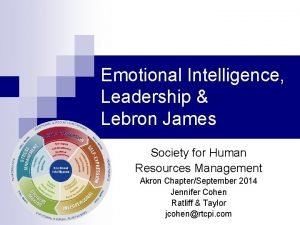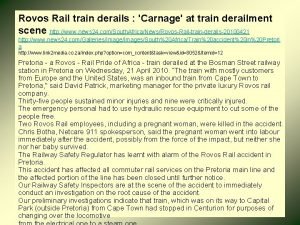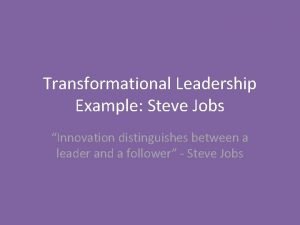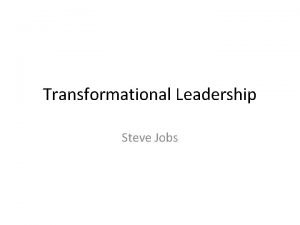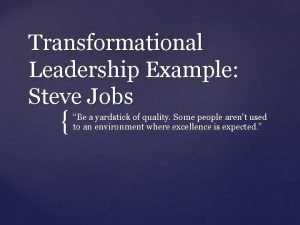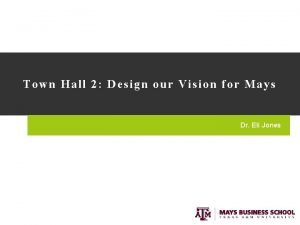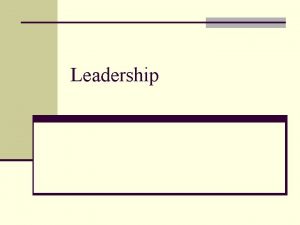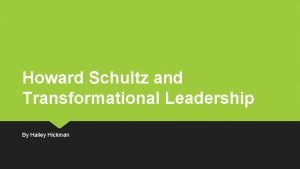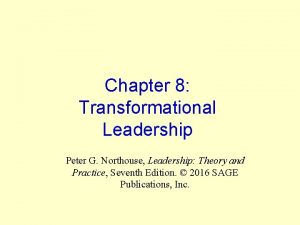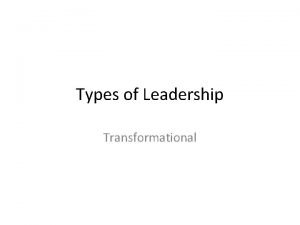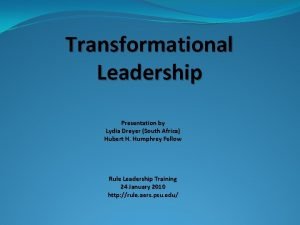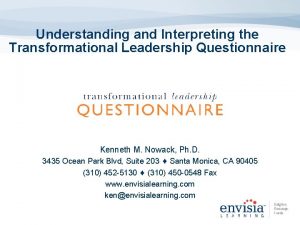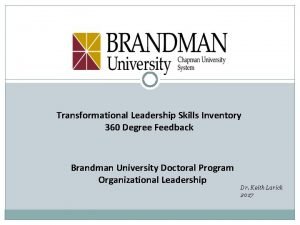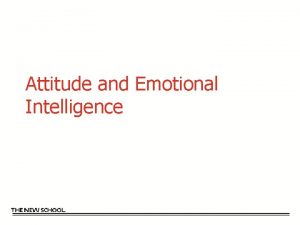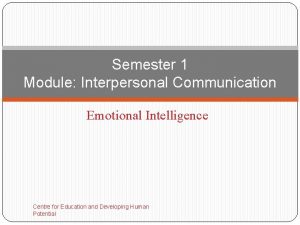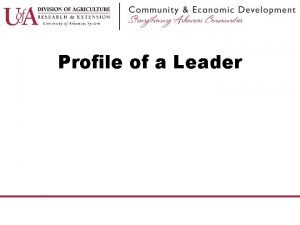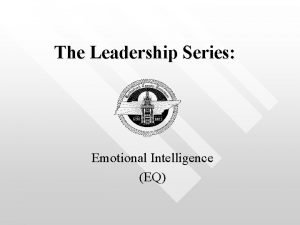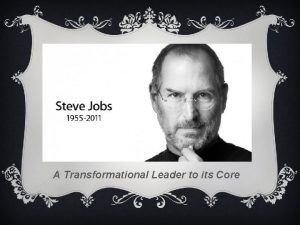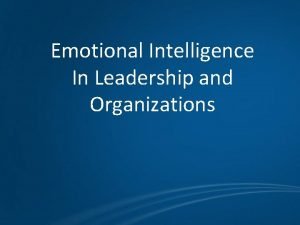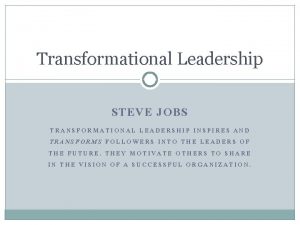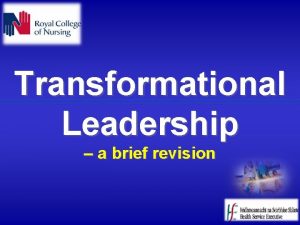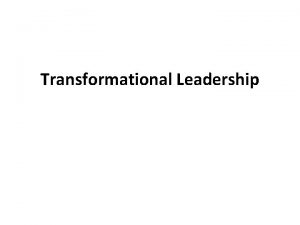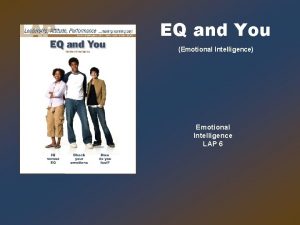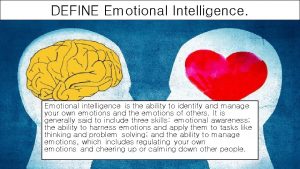Emotional Intelligence and Transformational Leadership Leader Derailment in



































- Slides: 35

Emotional Intelligence and Transformational Leadership: Leader Derailment in the Military-Industrial Complex 2016 American Meridian University International Interdisciplinary Academic and Business Conference Presenter: Dr. Matthew Anderson, Sr. The University of Phoenix: Center for Leadership Studies and Educational Research

Leader Derailment Quote Furnham (2006) proposed that “derailment and dark side leadership really is the Elephant in the Board-room: the taboo topic” (p. 4).

Why the Researcher’s initial interest? ØThe rate of leader failure is a concern to Organizations, as indicated by Hogan and Hogan (2009), who reported 65 to 75 % as the base rate for leadership failure. Ø The National Institutes for Occupational Safety and Health (NIOSH, 1999) reported that organization climate surveys revealed 75 % of the workers attributed their boss as being the most stressful aspect of their employment. Ø Fulmer and Congo (2004) noted the organizational impact of leader derailment and reported that the cost of a failed leader was between $500, 000 -2. 7 million, with $50 billion spent per year by the reporting organizations for leader developmental training and coaching. Ø Goleman (1995) commented that long periods of sadness and pessimism for leaders and organizational environments, which are toxic, hostile, cynical, suspicious, and tense, may double the risks of heart disease and respiratory and neurological disorders. Ø Derailed or failed/failing leaders are “a major health hazard, and impose enormous medical costs on society, and degrade the quality of life of many people” (Hogan & Hogan, 2009, p. 2).

Research Problem Statement Organizational Psychology Implications ü Scholars have studied leader derailment from the perspective of a variety of constructs, traits, characteristics, tendencies, dispositions, behaviors, and competencies, and with a variety of research methods, models, and measures. ü Scholars have not conclusively determined the constructs which may predict derailment (Harms, Spain, & Hannah, 2011; Johnson & Hill, 2009; Leslie & Van Velsor, 1996).

Research Literature Gap or Limitation ØResearchers have focused on the bright-side of personality as measured by models such as the five-factor model (FFM), and not on the dark-side or dysfunctional behaviors associated with leader derailment (Hogan & Hogan, 2009). ØLimitation: Lack of academic and professional consensus on the cause of leader derailment behaviors. Leader derailment behaviors describe a broad range of terminology with confusion underscoring the number of predictor variables that may provide a relationship (partially or wholly) for leader derailment. ØPurpose of this Current Study: Study the relationships that Emotional Intelligence and Transformational Leadership Style (independently) may have on leader derailment behaviors.

Research Question and Hypotheses Research Question: Are leader derailment behaviors best predicted by the relationships of emotional intelligence or transformational leadership style? H 01: EI competencies as assessed by the Emotional and Social Competency Inventory (ESCI) will not statistically significantly contribute to the prediction for leader derailment behaviors as assessed by the Hogan Development Survey (HDS) among leaders employed in the military-industrial complex population. H 11: EI competencies as assessed by the ESCI will statistically significantly contribute to the prediction for leader derailment behaviors as assessed by the HDS among leaders employed in the military-industrial complex population. H 02: TL style as assessed by the Global Transformational Leadership (GTL) Scale will not statistically significantly contribute to the prediction for leader derailment behaviors as assessed by the HDS among leaders employed in the military-industrial complex population. H 12: TL style as assessed by the GTL will statistically significantly contribute to the prediction for leader derailment behaviors as assessed by the HDS among leaders employed in the military-industrial complex population.

The Hogan Development Survey: Criterion Variables (11) Hogan and Hogan Model Assessed eleven dysfunctional behaviors that correspond to the Diagnostic and Statistical Manual of Mental Disorders. HDS value followed by the DSM-IV-TR value: excitable/borderline; skeptical/paranoid; cautious/avoidant; reserved/schizoid; leisurely/passive-aggressive; bold/narcissistic; mischievous/antisocial; colorful/histrionic; imaginative/schizotypal; diligent/obsessivecompulsive; and dutiful/criterion Destructive Leaders Charisma Personalized power Narcissism Negative life themes Ideology of hate Susceptible Followers Conformers Unmet Needs Low core self-evaluation Low Maturity Colluders Ambition Similar world view Bad Values Conducive Environment Instability Perceived threat Cultural values Lack of checks and balances and ineffective institutions Figure 1. 2 The Toxic triangle: elements in three domains related to destructive leadership, (Furnham, 2010, p. 22) Hogan, R. , & Hogan, J. (2009). Hogan Development Survey manual (2 nd ed. ). Tulsa, OK: Hogan Press.

Emotional and Social Competency Inventory Predictor Variables (12) Goleman and Boyatzis Model: Self-Awareness: 1. Emotional Self-Awareness Self. Management Emotional & Social Intelligence Relationship Management Social Awareness Self-Management: 2. Achievement Orientation 3. Adaptability 4. Emotional Self-Control 5. Positive Outlook Social Awareness: 6. Empathy 7. Organizational Awareness Relationship Management: 8. Conflict Management 9. Coach and Mentor 10. Influence 11. Inspirational Leadership 12. Teamwork Boyatzis, R. E. (2007). The creation of the emotional and social competency inventory (ESCI). (Hay Group Report). Boston, Ma. : Hay Group, p. 6.

Transformational Leader Scale Predictor Variable (1) Carless Model Communicates a Vision Develops Staff Is Charismatic Global Transformational Leads by Example Leadership (GTL) Scale Is Innovative Empowers Staff Carless, S. A. , Wearing, A. J. , & Mann, L. (2000). A short measure of transformational leadership. Journal of Business and Psychology, 14, 389 -405 Provides Support

Data Collection Response Rates Assessment(s) Self-report Formal Consent Forms Received Number of Type of Questions Response Rates 170 Demographic Profile Survey 11 Categorical Selection 152 Global Transformational Leader Scale 7 5 -point Likert Scale 152 Emotional Social Competency Intelligence Inventory 68 5 -point Likert Scale 165 Hogan Development Survey 168 True or False 135* Note: Decision made to use 135 research participants assessment data sets.

Research Participant Demographic Profile (n=152) Categorical Characteristic Largest Frequency Represented Frequency Percent Branch of Service Army 124 82 Employment Function Distribution Services 31 21 Number of Employees 10 or more 92 61 Gender Male 118 80 Marital Status Married 119 80 Years as a Leader Greater than 6 44 30 Age of Respondent 45 -54 56 38 Highest Education Level Graduate School 87 63 Race/Ethnicity European Descent/Caucasian 93 61 Economic Status $90 K or > $90 K 103 71 Years Employed 1 -5 and 26 or more 32 22 Note: Percent rounded to nearest whole number

Research Results Standard Multiple Regression Hypothesis 1: EI Predict Derailment Behaviors? Predictor variables: Achievement Orientation; Adaptability; Conflict Management; Coach and Mentor; Empathy; Emotional Self-Awareness; Emotional Self-Control; Inspirational Leadership; Influence; Organizational Awareness; Positive Outlook; Teamwork Criterion variables: Excitable; Skeptical; Cautious; Reserved; Leisurely; Bold; Mischievous; Colorful; Imaginative; Diligent; and Dutiful. Results: 11 Standard Regression Models Regression results indicated that based on the study sample there were no models which revealed statistical significance. Retained the null hypothesis: EI competencies as assessed by the Emotional and Social Competency Inventory (ESCI) did not statistically significantly contribute to the prediction of leader derailment behaviors as assessed by the Hogan Development Survey (HDS) among leaders employed in the military-industrial complex population.

Research Interpretations Standard Multiple Regression Hypothesis 1 Contemporary Empirical Study Findings: Lester, Hannah, Harms, Vogelgesang and Avolio (2011) conducted research with Army cadets (n=182) from the West Point military academy. Research examined the importance of EI competencies such as coach and mentor (CMT) and trust in the development of leader selfefficacy. Current study did not find a relationship that CMT and comparable EI competencies may have with regard to leadership derailment. Kilburg (2006) discussed the EI competency of organizational awareness (OA) from the perspective of leaders, senior leaders and executives of organizations. This current study reflected a participant majority who supervised 10 or more individuals (61. 3%) and had worked in their respective organizations for 26 or more years (21. 9%), thereby indicating a sample dominated by senior leaders. Kilburg proposed that there were core capabilities to a successful leader, like having and promoting organizational awareness in the team, and coaching, mentoring and fostering a positive environment amongst team members. Current study did not find predictive relationships between EI competencies: organizational awareness; coaching and mentoring, and derailment behaviors.

Research Interpretations Standard Multiple Regression Hypothesis 1 Current Study Supported Cherniss: Cherniss (2010) commented on enthusiasm for the construct of EI while suggesting moderation due to confusion and controversy. Suggested the primary confusion revolved around the plethora of definitions, models, and instruments available to measure the construct. Expressed concern over the relevancy of the EI construct to evaluate leadership effectiveness and work performance. Current Study was conducted to determine the relevancy of the constructs for an examination of the relationships of leaders’ competencies and dispositions. Current Study Supported Cherniss’s comments based on a determination of statistical nonsignificance for EI competencies predicting leader derailment dispositions.

Research Results Bivariate Linear Regression Hypothesis 2: T-Leadership Predict Derailment Behaviors? Predictor Variable: Transformational Leadership Score Criterion variables: Excitable; Skeptical; Cautious; Reserved; Leisurely; Bold; Mischievous; Colorful; Imaginative; Diligent; and Dutiful. Results: 11 Bivariate Linear Models Regression results indicated that based on the study sample there were no models which revealed statistical significance. Retained the Null Hypothesis: Transformational Leadership style as assessed by the Global Transformational Leadership (GTL) Scale did not statistically significantly contribute to the prediction of leader derailment behaviors as assessed by the HDS among leaders employed in the military-industrial complex population.

Research Interpretations Bivariate Linear Regression Hypothesis 2 Current Study Supported Contemporary Literature: Ø Extended the organizational psychology literature by examining the predictive relationships of the transformational style of leadership to derailment dispositions. Ø Provided academic support to the continuing application of the leadership style in leader development programs. Ø Current Study Findings: No conclusive support of a predictive relationship between the TL style of leadership and dispositions which may predict dark-side characteristics and result in a manifestation of DBs.

Research Summary Ø Research met the goal to address a limitation in the contemporary literature. Ø Current study determined statistic non-significance based on participant sample. Ø Non-significance IS a finding. Ø Recommend corroborating research based on varied samples from population. Ø Recommendations for research inquiries, techniques and instrument selection.

Questions, Comments and Observations Presenter: Dr. Matthew Anderson, Sr. The University of Phoenix: Center for Leadership Studies and Educational Research

Back Up Slides

Research Assumptions Ø Research participants: Ø Met the requirements as addressed in the information letter and informed consent to take the demographic survey and three assessments. Ø Honest in disclosures and responses, and understood the survey and assessment questions and provided candid and meaningful data. Ø Sample representative of the population of military-industrial complex leaders and yield generalizable interpretations to a population. Ø Participants who decided not to participate (wholly or partially) in the study did not affect the outcome of the analysis, interpretations and report of findings Ø Assessments were reliable, valid and normalized measures of the proposed study constructs.

Sampling Methodology Criteria and Size Ø Research Participants Criteria: Ø Leaders in the military-industrial complex population and employed in the U. S. military services/branches (Army, Air Force, Navy, Marines, and Coast Guard) and industrial defense suppliers and service providers who contract and provide supplies and services to the military. Ø Leaders were assigned in a leadership role in organizations, groups, academies, or associations and were contacted by means of professional media and forums, or military service command distribution channels. Ø Sample Size: Ø Gpower 3. 1. 2, a general power analysis program (Buchner, Erdfelder, Faul, & Lang, 2009) was used to derive a recommended 131 research participants for the regression analyses.

Sample Methodology: Three Methods to Recruit 1. Contacted via Leadership Organizations (Internet) and provided a Recruitment Flyer, Informational Letter and a Formal Consent Form. 2. Snowball sampling (Goodman, 1961; 2011) whereby instructions were provided to nominate and refer five or more additional qualified research candidates to the researcher for selection screening and processing. 3. Convenience sampling (Creswell, 2009) whereby the researcher had direct knowledge of the convenient accessibility and proximity of the research candidates through professional leadership forums.

Research Interpretations Standard Multiple Regression Hypothesis 1 Theoretical Literature Propositions: Ø Goleman and Boyatzis (2008) developed an Emotional Intelligence behavioral model and ESCI assessment to be applied to a broad range of leadership roles, work contexts, and levels of leadership (entry, midlevel, and senior/executive). Ø Dalal and Nolan (2009) and Davis (2011) proposed Emotional Intelligence as a core construct for behaviors associated with derailment. Ø Gap in Research Literature: ESCI inventory has not been applied to a predictive study based on an examination of the relationships associated with derailment dispositions.

Research Interpretations Bivariate Linear Regression Hypothesis 2 Theoretical Literature Propositions: Ø Howell and Avolio (1993) proposed that the TL style dimensions predicted short-term performance. Ø Geyer and Steyrer (1998) stated that the TL style of leadership predicted long-term performance. Ø Hogan and Hogan (2009) proposed concerns with this style of leadership with regards to the potential of “over-engaging behaviors [while] getting bogged down in the details” (p. 87).

Limitations to Generalizations 1. Data analyzed in the research was heavily dependent and bounded by the participants demographics and the responses from these respondents. 2. Norming criteria of the assessments was based on a culturally individualistic sample (i. e. , United States, United Kingdom, Europe and Australia) and not collectivistic cultures. 3. Study used three self-report Internet-conducted measures. Participants may not have been honest in meeting the criteria for eligibility for the leadership study. May have selected responses on the three self-report assessments which were not truthful or honest. 4. Potential candidates, otherwise qualified and motivated to participate, were unknown to the researcher, and hence were not invited to participate. 5. Participant mortality rate did occur as 170 leaders signed consent to participate: 152 completed the GTL and Profile Survey, 165 completed the ESCI, and 135 completed the HDS.

Comments: Future Research Study Instruments and Techniques How should leader derailment be measured and assessed? --Sample size considerations for the HDS and 11 criterion variables --Bonferroni adjustment effect used to obviate Type I error --Instrument(s) considerations for Future Research --Alternate statistical techniques to address the data: Requires robust sample --Factorial MANOVA: Technique to assess comparison of group means when addressing multiple criterion variables and may have allowed for a different interpretative finding of the data. --Principal Components Analysis: Factor data reduction technique and a method to potentially reveal groupings of factors that are measuring a common construct.

Recommendations Future Research 1. Assess participants with the 360 -degree assessment for the ESCI and GTL. May result in different and more reliable scores based on the 360 -employment team. 2. Study of a single service of the Armed Forces rather than all services and branches, for example the Navy or the Air Force. 3. Study of a single organization or enterprise to examine the industrial aspect of the military-industrial complex, for example Boeing or Raytheon. 4. Study one leadership category, for example the mid-level manager. 5. Study the data organized into three categories: entry, mid-level, and seniorlevel; and conduct statistical analyses to determine significance of mean group differences. 6. Study women and/or minorities leader derailment in the military-industrial sector.

Implications for Social Change Dollars, Disease, Disability and Death 1. Study addressed a limitation and a gap in the literature by examining emotional intelligence competencies, transformational leadership behaviors, and dispositions which may indicate dysfunctional leadership. 2. Assessments used in this study were self-report/awareness and do not require excessive resources or human resource personnel training (dollars) to screen for the design of the construct measurement. 3. Derailing leaders may suffer adverse physiological and psychological health impacts (disease, disability, and, in extreme cases, death). Recommend continued research focused on EI and the relationship to derailment dispositions. 4. Transformational leadership is a popular leadership style taught in development programs in the public, private, and military sectors. Recommend continued research focused on TL and the relationship to derailment dispositions.

What are future plans for this research? Briefing and publishing results of the research findings to assist in guiding research considerations for future study of leader derailment.

Emotional Intelligence Categories: Ability, Trait, & Mixed-Models Goleman Theorist Time Frame Theory Framework Spearman 19001904 Discussion of general or ‘g’ Intelligence Binet 19001920 Development of IQ Test E. Thorndike 1920 Abstract, mechanical and social intelligence R. Thorndike 19301940 Social Intelligence, complex range of abilities Wechsler 19301940 s Affective components of intelligence Cattell 1943 Fluid and crystallized intelligences Maslow 1950 s Described how to create ‘emotional strength’ Sternberg 19701980 s Triarchic theory of intelligence, focus on creative aspects Emotional Social Competency Intelligence Bar-On Mixed Model EI of noncognitive competencies Gardner Multiple Intelligences (1975 -1983) Petrides Trait EI: innate and genetic Mayer, Salovey and Caruso Ability EI

Transformational Leadership: Five Leadership Dimensions (Bass Model) Individualized Consideration Attends to follower’s professional development & advancement Idealized Attributes and Idealized Behaviors (2 dimensions) Role model for ethical behaviors, gains trust and respect Intellectual Stimulation Transformational Leadership Inspirational Motivation Establishes a inspiring and appealing ‘Vision’ for followers Bass, B. M. (1990). From transactional to transformational leadership: Learning to share the vision. Organization Dynamics, 18(3), 19 -31. Leader challenges status quo, and solicits followers’ ideas

References Bass, B. M. (1990). From transactional to transformational leadership: Learning to share the vision. Organization Dynamics, 18(3), 19 -31. Boyatzis, R. E. (2007). The creation of the emotional and social competency inventory (ESCI). (Hay Group Report). Boston, Ma. : Hay Group. Buchner, A. , Erdfelder, E. , Faul, F. , & Lang, A. (2009). G*Power (Version 3. 1. 2) [Computer program]. Carless, S. A. , Wearing, A. J. , & Mann, L. (2000). A short measure of transformational leadership. Journal of Business and Psychology, 14, 389 -405 Cohen, J. (1992). A power primer. Psychological Bulletin, 112, 155 -160. doi: 10. 1037/0033 -2909. 112. 1. 155 Corona, V. (2011). Career patterns in the U. S. Army officer corps. Public Organization Review, 11(2), 109134. doi: 10. 1007/s 11115 -010 -0114 -7 Creswell, J. W. (2009). Research design: Qualitative, quantitative and mixed methods approaches (3 rd ed. ). Thousand Oaks, CA: Sage Publications, Inc. Feller, B. , & Jelinek, P. (2012, Jan 5). Obama unveiling defense strategy, military cuts. The Huffington Post. Retrieved June 18, 2012, from http: //www. huffingtonpost. com/2012/01/05/obama-defense-strategy -military-cuts_n_1186025. html. Fulmer, R. M. , & Conger, J. (2004). Growing your company's leaders [electronic resource]: How great organizations use succession management to sustain competitive advantage. New York: AMACOM. Furnham, A. (2010). The elephant in the boardroom. Palgrave Macmillan. Goleman, D. (1995). Emotional intelligence. New York, NY: Bantam Books.

References Goleman, D. , Boyatzis, R. , & Hay, G. (2002). Emotional Competence Inventory. Boston, Ma. , Hay Group. Goleman, D. , (2006). Social Intelligence. New York, NY: Bantam Books. Goodman, L. A. (1961). Snowball sampling. Annals of Mathematical Statistics, 32(1), 148– 170. doi: 10. 1214/aoms/1177705148 Goodman, L. A. (2011). Comment: On respondent-driven sampling and snowball sampling in hard-toreach populations and snowball sampling not in hard-to-reach populations. Sociological Methodology, Vol. 41, 347 -353. doi: 10. 2307/41336926 Halpin, S. M. (2011). Historical influences on the changing nature of leadership within the military environment. Military Psychology, 23(5), 479 -488. doi: 10. 1080/08995605. 2011. 600138 Harms, P. D. , Spain, S. M. , & Hannah, S. T. (2011). Leader development and the dark side of personality. The Leadership Quarterly, 22, 495 -509. doi: 10. 1016/j. leaqua. 2011. 04. 007 Hogan, R. , & Hogan, J. (2009). Hogan Development Survey manual (2 nd ed. ). Tulsa, OK: Hogan Press. Johnson, J. L. , & Hill, W. R. (2009). Personality traits and military leadership. Individual Differences Research, 7(1), 1 -13.

References Leslie, J. , & Van Velsor, E. (1996). A look at derailment today: North America and Europe / Jean Brittain Leslie, Ellen Van Velsor. Greensboro, N. C. : Center for Creative Leadership. Losey, T. (2012, July 2012). Forecast: 89, 000 civilian job cuts at Do. D under sequestration. Federal Times. Retrieved November 13, 2012, from 1 http: //www. federaltimes. com/article/20120726/DEPARTMENTS 01/307260006/Forecast-89 -000 -civilian-jobcuts-Do. D-under-sequestration Mertler, C. A, & Vannatta, R. A. (2010). Advanced and multivariate and statistical methods: Practical application and interpretation (4 th ed. ). Los Angeles: Pyrczak. National Institute for Occupational Safety and Health. (1999). Stress at work. (U. S. National Institute for Occupational Safety and Health, DHHS, Publication Number 99 -101). Washington, DC: Author. Peter. L. (1985). Why things go wrong. London: Unwin. Rizzo, J. , & Lawrence, C. (2012, July 10). Threat of defense cuts a fear factor on campaign trail. CNN Security Clearance. Retrieved July 24, 2012, from http: //security. blogs. cnn. com/2012/07/10/threat-of defense-cutscreates workplace-fear-factor/

Dissertation Defense Agenda Part I: Research Methodology Ø Ø Ø Ø Research Problem and Literature Limitation Research Question and Hypotheses Criterion and Predictor Variables and Models (Quick Review) Research Assumptions Sampling Methodology Data Measurements Response Rates Research Participant Demographic Profile ØPart II: Research Results and Interpretations Ø Standard Multiple Regression: Hypothesis Test 1 ØLiterature Support and Comments Ø Bivariate Linear Regression: Hypothesis Test 2 ØLiterature Support and Comments ØPart III: Recommendations and Implications Ø Ø Ø Limitations to generalizations Comments: Study Instruments and Analyses Recommendations for Future Research Implications for Social Change Summary and Way Ahead
 Transactional leadership vs transformational leadership
Transactional leadership vs transformational leadership Leadership derailment
Leadership derailment Leadership derailment
Leadership derailment Global leadership foundation emotional intelligence test
Global leadership foundation emotional intelligence test Rovos rail derailment
Rovos rail derailment Transformational leader steve jobs
Transformational leader steve jobs Idealized influence meaning
Idealized influence meaning Steve jobs transformational leadership style
Steve jobs transformational leadership style Steve jobs transformational leader
Steve jobs transformational leader Transformational leadership steve jobs
Transformational leadership steve jobs Mays transformational leader mindsets
Mays transformational leader mindsets Steve jobs transformational leader
Steve jobs transformational leader Was steve jobs a transformational leader
Was steve jobs a transformational leader Gandhi transformational leadership
Gandhi transformational leadership Kouzes and posner 2002
Kouzes and posner 2002 Smooth running
Smooth running Transformational leadership factors the 4 i's
Transformational leadership factors the 4 i's Howard schultz transformational leadership
Howard schultz transformational leadership Howard schultz transformational leadership
Howard schultz transformational leadership Northouse 2016 transformational leadership
Northouse 2016 transformational leadership Transformational synonym
Transformational synonym Transformational leadership presentation
Transformational leadership presentation Transformational leadership inventory
Transformational leadership inventory Idealized influence
Idealized influence Inventory360
Inventory360 Transformational leadership four i's
Transformational leadership four i's Full range leadership model
Full range leadership model Transformational leadership
Transformational leadership Transcendent leadership vs transformational
Transcendent leadership vs transformational Steps for transformational leadership
Steps for transformational leadership Transactional leadership
Transactional leadership Madcud
Madcud Interpersonal communication and emotional intelligence
Interpersonal communication and emotional intelligence Function of leadership
Function of leadership Emotional intelligence objectives
Emotional intelligence objectives Oka emotional intelligence
Oka emotional intelligence



